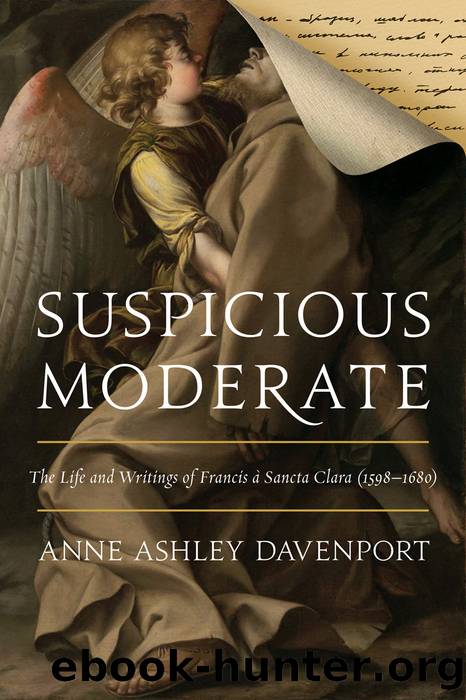Suspicious Moderate by Davenport Anne Ashley;Peters Danielle M.;

Author:Davenport, Anne Ashley;Peters, Danielle M.;
Language: eng
Format: epub
Publisher: University of Notre Dame Press
Published: 2017-08-15T00:00:00+00:00
SANCTA CLARA AND JEREMY TAYLOR, AGAIN
How does Systema fidei compare to Jeremy Taylorâs treatise on religious diversity and toleration, Theologia eklektike, subtitled A discourse on the liberty of prophesying (1647)? Like Sancta Clara, Taylor denies that Christian unity requires unanimity of opinion in matters that are not necessary for salvation. So long as human beings, Taylor says, have âsuch a variety of principles, such severall constitutions, educations, tempers and distempers, hopes, interests and weaknesses, degrees of light and degrees of understanding,â it will be impossible to reduce them to conformity.152 Like Sancta Clara, Taylor argues that the solution is to recognize that there is no intrinsic harm in disagreeing over âlegitimate matters.â153 And just as Sancta Clara consciously took the risk of being accused of inappropriate moderation, Taylor fully expected to be accused of promoting religious âindifferencyâ and sought to prove that freedom of conscience in âlegitimate mattersâ does not imperil Christian fervor.
Like Systema fidei, Taylorâs Liberty of prophesying allows diversity of opinions in speculative matters but does not allow disagreement in fundamental âmatters of Creed.â Like Sancta Clara, Taylor carefully distinguishes articles of faith, to which all Christians must fully and unconditionally adhere if they hope to be saved, from âdoubtfull Disputationsâ and âindifferentâ matters, where diversity of opinion is permissible.154 Unlike Sancta Clara, however, Taylor gives no credit to the Roman Church for championing the distinction or for invoking it to protect speculative freedom. Rather, Taylor blames the Roman Church for the rise of dogmatic intransigence. Rome, he says, departed from the âeclecticâ benevolence of the early Church and initiated the policy of imposing human opinions as articles of faith on all Christians, thus producing schismatics and heretics who were then violently persecuted.155 Sancta Clara and Taylor, in other words, disagree on how to interpret the historical record. Sancta Clara interprets the Roman Church to have been legitimately engaged in clarifying doctrines of the Faith for the sake of preventing schism, while Taylor interprets the Roman Church to have been cynically engaged in corrupting Christâs Faith for the sake of political hegemony.
What does Taylor take to be the rule of faith? Taylor argues that the Nicene Creed, as such, suffices to define the whole of Christian faith.156 In sharp contrast to Sancta Clara, Taylor explicitly denies that the logical consequences of the Nicene Creed are themselves articles of faith and denies that ecumenical councils have the authority to make them so.157 Since Sancta Clara, however, concedes that fundamentalia do not put Christians under exactly the same absolute obligation as fundamenta, and since Taylorâs advocacy of personal reason as the safest guide makes it difficult to see how the Nicene Creed can be rationally separated from its own logical implications, the difference between the two views may well be more apparent than real.158
According to Taylor, heresy never applies to âpious persons.â159 Would Sancta Clara disagree? Since Sancta Clara counts anyone in communion with Godâs church as a âpious person,â and since the only requirement for being in communion with
Download
This site does not store any files on its server. We only index and link to content provided by other sites. Please contact the content providers to delete copyright contents if any and email us, we'll remove relevant links or contents immediately.
4 3 2 1: A Novel by Paul Auster(11788)
The handmaid's tale by Margaret Atwood(7446)
Giovanni's Room by James Baldwin(6807)
Asking the Right Questions: A Guide to Critical Thinking by M. Neil Browne & Stuart M. Keeley(5355)
Big Magic: Creative Living Beyond Fear by Elizabeth Gilbert(5350)
Ego Is the Enemy by Ryan Holiday(4954)
On Writing A Memoir of the Craft by Stephen King(4660)
The Body: A Guide for Occupants by Bill Bryson(4580)
Ken Follett - World without end by Ken Follett(4441)
Bluets by Maggie Nelson(4259)
Adulting by Kelly Williams Brown(4231)
Eat That Frog! by Brian Tracy(4147)
Guilty Pleasures by Laurell K Hamilton(4115)
White Noise - A Novel by Don DeLillo(3828)
The Poetry of Pablo Neruda by Pablo Neruda(3813)
Fingerprints of the Gods by Graham Hancock(3731)
Alive: The Story of the Andes Survivors by Piers Paul Read(3728)
The Book of Joy by Dalai Lama(3694)
The Bookshop by Penelope Fitzgerald(3615)
